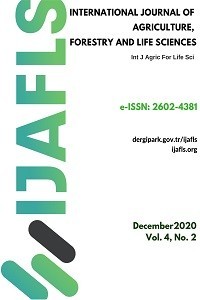COMPARATIVE ADVANTAGE ANALYSIS FOR TURKISH GRAPE AND CHERRIES EXPORT MARKET
COMPARATIVE ADVANTAGE ANALYSIS FOR TURKISH GRAPE AND CHERRIES EXPORT MARKET
export competition, indices, grape, cherries, Turkey,
___
- Miran, B., Atış, E., Kenanoğlu Bektaş, Z., Cankurt, M., Bayaner, A., Karabat, S. 2015. Uluslararası kuru üzüm piyasasında rekabet edebilirlik üzerine bir araştırma. Tarım Ekonomisi Araştırmaları Dergisi, 1(1): 40-47. (A research on competitiveness in international raisins market, Journal of Agricultural Research)Duran, M. 2003. Üzüm etüdü. İstanbul Ticaret Odası Dış Ticaret Araştırma Servisi. Mart 2003, 1-41. (Grape research. Foreign Trade Research Unit of Istanbul Chamber of Commerce)
- FAO, 2012. FAOSTAT Statistical database. (http://www.fao.org). Accessed: 25.09.2014.
- Cebeci, E. and Akin, A. 2012. Mersin ili üzüm ihracatının Türkiye ekonomisi içindeki yeri ve öneminin değerlendirilmesi. COMU J Agric. Fac. 2014: 2 (2): 119–129. (Assessment of place and importance of grape exports of Mersin province in Turkish economy)
- FAO, 2016. FAOSTAT Statistical Database. (http://www.fao.org). (accessed: 07.08.2018).
- Müller, C., Vermeulen, W.J.V. and Glasbergen, P. 2009. Perceptions on the demand side and realities on the supply side: A Study of the South African table grape export industry. Sustainable Development Sust. Dev. 17, 295–310.
- Gul, M., Kart, M.C.O., Yilmaz, S.G., 2016. Uzunkaya, K. Opportunities and constraints for cherry exporters in Turkey.
- Cercinli Oz, F. and Bal, T. 2016. İhracatçı açısından Isparta ili kiraz ihracatının analizi. Journal of Agricultural Faculty of Mustafa Kemal University. 21(1):71-82. (Analysis of cherries exports of Isparta province from exporters’ view)
- Anonymous. 2015. Trademap, 2015, Trade Statistics for International Business Development, http://www.trademap.org (accessed: 20.01.2016)
- UN Comtrade, 2018, data withdrawn from: https://comtrade.un.org/ (accessed: 07.2018).
- Balassa, B. 1965. Trade liberalisation and ‘revealed’ comparative advantage. Manchester School of Economic and Social Studies 33(1)99-123.
- French, S. 2017. Revealed comparative advantage: What is it good for? Journal of International Economics 106 (2017) 83–103.
- Jaimovich, E. and Merella V. 2015. Love for quality, comparative advantage, and trade. Journal of International Economics 97 (2015) 376–391.
- Vollrath, L. T. 1987. Revealed competitive advantage for wheat. Economic Research Service Staff Report No: AGES861030, US Department of Agriculture, Washington DC.
- Vollrath, L. T. 1989. Competitiveness and protection in world agriculture. Agricultural Information Bulletin No: 567, Economic Research Service, US Department of Agriculture, Washington DC.
- Vollrath, L. T. 1991. A theoretical evaluation of alternative trade intensity measures of revealed comparative advantage. Weltwirtschaftliches Archiv 127 (2): 263-280.
- Vollrath, L. T. and De Huu Vo 1990. Agricultural competitiveness in an independent world. In: ‘Agriculture and Governments in an Independent World’. International Association of Agricultural Economists Occasional Paper No: 5 (Aldershot: Gower)
- Ferto, Imre and Hubbard, L. J. 2003. Revealed Comparative advantage and competitiveness in Hungarian agri-food sectors. The World Economy 26(2): 247-259.Serin, Vildan; and Civan, A. 2008. Revealed comparative advantage and competitiveness: A case study for Turkey towards the EU. Journal of Economic and Social Research 10(2): 25-41.
- Anonymous. 2018a. Official exchange rates from Central Bank of Turkey, (http://www.tcmb.gov.tr/kurlar/kurlar_tr.html (accessed: 05.08.2018)
- Anonymous. 2018b. Official exchange rates from Central Bank of Egypt, http://www.cbe.org.eg/en/EconomicResearch/Statistics/Pages/OfficialRatesHistorical.aspx (accessed: 05.08.2018)
- Arellano, M. 2003. Panel data econometrics. Oxford University Press, New York, 231 pp.
- Levin A., Lin, C.F. and Chu, C. J. 2002. Unit root tests in panel data: asymptotic and finite sample properties. Journal of Econometrics 108 (revise version of 1992’s work):1-24.
- Levin, A. and Lin, C.F. 1992. Unit root test in panel data: asymptotic and finite-sample properties. Discussion paper: 92-93, Department of Economics, University of California at San Diego (PDF) Panel unit root tests: A review. https://www.researchgate.net/publication/252756953_Panel_Unit_Root_Tests_A_Review [accessed Aug 14 2018].
- Levin, A. and Lin, C.F. 1993. Unit root test in panel data: new results. Discussion paper, 93-56, Department of Economics, University of California at San Diego. (PDF) Panel Unit Root Tests: A Review. Available from: https://www.researchgate.net/publication/252756953_Panel_Unit_Root_Tests_A_Review [accessed Aug 14 2018].
- Pedroni, P. 1999. Critical values for cointegration tests in heterogeneous panels with multiple regressors. Oxford Bulletin of Economics and Statistics, Special Issue (1999): 0305-9049.
- Breusch, T and Pagan, A. 1979. A simple test for heteroscedasticity and random coefficient variation. Econometrica, 47(5): 1287-94.
- Godfrey, L. 1978. Testing against general autoregressive and moving average error models when the regressors include lagged dependent variables. Econometrica, 1978, vol. 46, issue 6, 1293-1301.
- Baltagi, Badi H. 2005. Econometric analysis of panel data /ISBN 0-470-01456-3
- Deardorff, A.V. 2013. Growth or decline of comparative advantage. Journal of Macroeconomics 38(2013): 12–18.
- Eaton, J., Kortum, S., 2002. Technology, geography, and trade. Econometrica 70(5): 1741–1779.Utkulu, U. and Seymen, E., 2004. Revealed comparative advantage and competitiveness: evidence for Turkey vis-à-vis the EU/15. Presented at the European Trade Study Group 6th Annual Conference, ETSG 2004, Nottingham, September 2004.
- Sahinli, M., 2014. Revealed Comparative advantage and competitiveness: Turkey agriculture sector. YYU J AGR SCI, 2014, 24(3): 210-217.
- Gujarati, D. N., 2003. Basic Econometrics. New York: McGraw Hill Book Co.
- Yayın Aralığı: Yılda 2 Sayı
- Başlangıç: 2017
- Yayıncı: Volkan OKATAN
EFFECT OF CLIMATE CHANGE ON MUNGBEAN GROWTH AND PRODUCTIVITY UNDER EGYPTIAN CONDITIONS
Ezzat ABD EL LATEFF, Mostafa ABD EL-SALAM, Mostafa SELIM, Medhat TAWFIK, Mohamad EL-KRAMANY, Aziza FARRAG
Jessie SABIJON, Michael Adonis SUDARIA
Jessie SABIJON, Michael Adonis SUDARIA
Miroslav ŠLOSÁR, Alžbeta HEGEDŰSOVÁ, İvana MEZEYOVÁ, Mária TIMORACKÁ, Ondrej HEGEDŰS
COMPARATIVE ADVANTAGE ANALYSIS FOR TURKISH GRAPE AND CHERRIES EXPORT MARKET
Rahmiye Figen CEYLAN, Cengiz SAYIN, Burhan OZKAN, Metin Göksel AKPINAR, Eda İLBASMIŞ
THE POSSIBILITY OF BUTTERNUT SQUASH GROWING IN CONDITIONS OF SLOVAK REPUBLIC
Alena ANDREJIOVA, Alžbeta HEGEDUSOVÁ, Adriána MAŤOVÁ, Andrea VARGOVÁ
EFFECTS OF PERIODS AND ALTITUDES ON THE PHENOLIC COMPOUNDS AND OIL CONTENTS OF OLIVES, cv. AYVALIK
Serhat USANMAZ, Fehmi ÖZTÜRKLER, Murat HELVACI, Turgut ALAS, İbrahim KAHRAMANOĞLU, Mehmet Atilla AŞKIN
SOCIODEMOGRAPHIC CHARACTERISTICS OF SMALL RUMINANT FARMERS: ŞIRNAK PROVINCE SAMPLE
